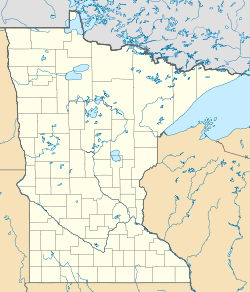
Winona State University (WSU) is a public university in Winona, Minnesota. It was founded as First State Normal School of Minnesota in 1858 and is the oldest member of the Minnesota State Colleges and Universities System. It was the first normal school west of the Mississippi River.

Sugar Loaf is a bluff on the Mississippi River topped by a rock pinnacle, overlooking the city of Winona, Minnesota, United States. The name "Sugar Loaf" is sometimes taken to mean just the rock pinnacle, which was created by quarrying in the 19th century. The bluff stands above the junction of U.S. Route 61 and State Highway 43. It towers 500 feet (150 m) over Lake Winona, and the pinnacle rises more than 85 feet (26 m) above the remainder of the bluff.

Watkins Incorporated is a manufacturer of health remedies, baking products, and other household items. Founded in 1868, Watkins Incorporated is based in Winona, Minnesota, United States, which utilizes an omni-channel marketing strategy which includes a national retail sales force which focuses on selling to the retail channel as well as an independent sales force of 25,000 people to distribute its products.

The Winona County Courthouse is the seat of government for Winona County in Winona, Minnesota, United States. The 1889 Richardsonian Romanesque building was listed on the National Register of Historic Places in 1970 for having local significance in the themes of architecture, art, and politics/government. It was nominated for being an artistic manifestation of Winona's prosperous riverboat and logging era. It was the first courthouse in Minnesota listed on the National Register.

Winona station, formerly known as the Chicago. Milwaukee & St. Paul Railway Station, is a historic train station in Winona, Minnesota, United States. It is served by Amtrak's daily Empire Builder service. It was originally built in 1888 by the Chicago, Milwaukee, St. Paul and Pacific Railroad, known later as the Milwaukee Road. A former Milwaukee Road freight house also exists here.

This list is of the properties and historic districts which are designated on the National Register of Historic Places or that were formerly so designated, in Hennepin County, Minnesota; there are 190 entries as of April 2023. A significant number of these properties are a result of the establishment of Fort Snelling, the development of water power at Saint Anthony Falls, and the thriving city of Minneapolis that developed around the falls. Many historic sites outside the Minneapolis city limits are associated with pioneers who established missions, farms, and schools in areas that are now suburbs in that metropolitan area.
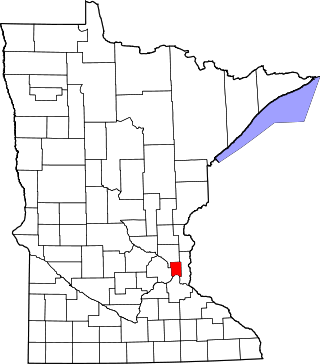
This is a complete list of National Register of Historic Places listings in Ramsey County, Minnesota. It is intended to be a complete list of the properties and districts on the National Register of Historic Places in Ramsey County, Minnesota, United States. The locations of National Register properties and districts for which the latitude and longitude coordinates are included below, may be seen in an online map.

Merchants National Bank is a bank building in Winona, Minnesota, United States, designed in the Prairie School architectural style. It was built in 1912 and features elaborate terracotta and stained-glass ornamentation. It was listed on the National Register of Historic Places in 1974 for having state-level significance in the themes of architecture and commerce. It was nominated for being the "largest and probably best example" of the 18 Midwestern banks designed by Purcell, Feick & Elmslie, a significant influence on early-20th-century American architecture. It is also a contributing property to the Winona Commercial Historic District.

This is a list of the National Register of Historic Places listings in Saint Louis County, Minnesota. It is intended to be a complete list of the properties and districts on the National Register of Historic Places in Saint Louis County, Minnesota, United States. The locations of National Register properties and districts for which the latitude and longitude coordinates are included below, may be seen in an online map.

This is a list of the National Register of Historic Places listings in Stearns County, Minnesota. It is intended to be a complete list of the properties and districts on the National Register of Historic Places in Stearns County, Minnesota, United States. The locations of National Register properties and districts for which the latitude and longitude coordinates are included below, may be seen in an online map.

This is a list of the National Register of Historic Places listings in Winona County, Minnesota. It is intended to be a complete list of the properties and districts on the National Register of Historic Places in Winona County, Minnesota, United States. The locations of National Register properties and districts for which the latitude and longitude coordinates are included below, may be seen in an online map.

This is a list of the National Register of Historic Places listings in Le Sueur County, Minnesota. It is intended to be a complete list of the properties and districts on the National Register of Historic Places in Le Sueur County, Minnesota, United States. The locations of National Register properties and districts for which the latitude and longitude coordinates are included below, may be seen in an online map.
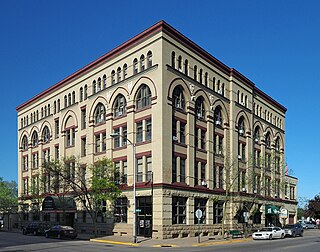
The Winona Hotel is a former hotel building in Winona, Minnesota, United States, constructed in 1889. It was listed on the National Register of Historic Places in 1983 for having local significance in the themes of architecture and commerce. It was nominated for its locally distinctive Romanesque Revival architecture and origin as a hotel specifically constructed to accommodate out-of-town visitors during Winona's heyday as a fine theatre destination. The Winona Hotel is also a contributing property to the Winona Commercial Historic District. Now known as The Kensington, the building has been converted to senior apartments.

This is a list of the National Register of Historic Places listings in Lac qui Parle County, Minnesota. It is intended to be a complete list of the properties and districts on the National Register of Historic Places in Lac qui Parle County, Minnesota, United States. The locations of National Register properties and districts for which the latitude and longitude coordinates are included below, may be seen in an online map.

This is a list of the National Register of Historic Places listings in Mower County, Minnesota. It is intended to be a complete list of the properties and districts on the National Register of Historic Places in Mower County, Minnesota, United States. The locations of National Register properties and districts for which the latitude and longitude coordinates are included below, may be seen in an online map.
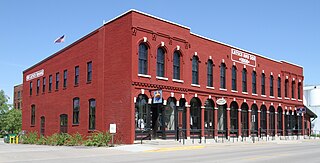
The Latsch Building is a historic commercial property in Winona, Minnesota, United States. Once known as the Kupietz Block, it was constructed in stages from 1860 to the 1880s. It was listed on the National Register of Historic Places in 1975 for having local significance in the themes of architecture and commerce. It was nominated for its transitional Gothic Revival/Italianate architecture and its former occupation by the largest of several produce wholesalers that based themselves in Winona to take advantage of the city's river and rail connections.

Winona City Hall is the seat of municipal government for Winona, Minnesota, United States. It was built with federal funding from the Public Works Administration in 1939.

The Winona and St. Peter Railroad Freight House is a former freight house in Winona, Minnesota, United States. Built from 1882 to 1883, it is the city's last surviving freight facility of the Winona and St. Peter Railroad. The building was listed on the National Register of Historic Places in 1984 for having local significance in the theme of transportation. It was nominated as a symbol of the Winona and St. Peter Railroad, which was instrumental in spurring Winona's industry and growth by developing markets along its rail lines across Minnesota and into Dakota Territory.
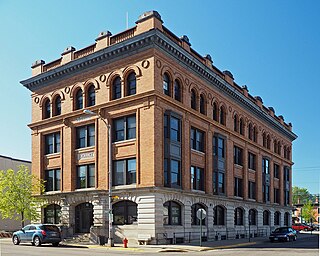
The Grain and Lumber Exchange Building is a historic office building in Winona, Minnesota, United States. It was designed in Renaissance Revival style by the architectural firm of Kees & Colburn and built in 1900. The building was listed on the National Register of Historic Places in 1977 for its local significance in the theme of architecture. It was nominated for being among Winona's most architecturally distinctive office buildings from the turn of the 20th century. It is also notable for being designed to the specifications of its first tenants even though they were primarily renters rather than owners.
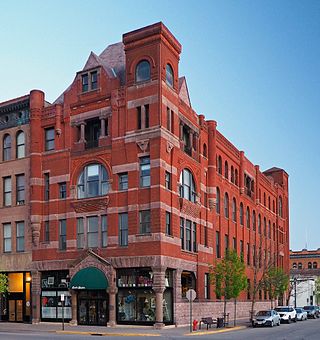
The Choate Department Store is a historic commercial building in Winona, Minnesota, United States. It was built in 1881 for Hannibal Choate (1835–1923), an early Winona-based merchant who achieved such regional prominence that he became known as the "merchant prince of southeastern Minnesota". The building was listed on the National Register of Historic Places in 1976 for its local significance in the theme of commerce. It was nominated for its associations with Choate, who pioneered fixed price retail and in-store merchandise displays in the region, and boosted his bottom line by wholesaling to other merchants.

